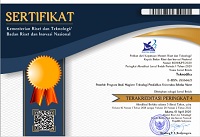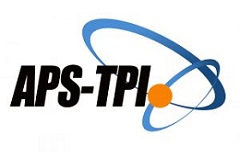Article components
Title of the article should be written in a compact, clear, and informative sentence, preferably not more than 20 words. Name of author(s) should be completely written, especially for the first and the last name. Name and institution address should also be completely written. We choose local names in Bahasa Indonesia for universities in Indonesia. The mention of "graduate program", "undergraduate program", "post-graduate program", "master program", "doctoral program" should be avoided in the name of institution. Manuscript written by a group, author for correspondence along with address is required. The title page (first page) should include the title of the article, full name(s), institution(s) and address(es) of the author(s); the corresponding author mentions the detail email addresses.
Abstract A concise abstract is required (about 250 words maximum). The abstract should be informative and state the background of the research, the study's aim, the principal results and major conclusions briefly. An abstract is often presented separately from the article; thus, it must stand alone (completely self-explanatory). References should not be cited, but if essential, then cite the author(s) and year(s). Abbreviations should be avoided, but if essential, they must be defined at their first mention.
Keywords is about five words, covering scientific and local name (if any), research theme, and special methods which used; and sorted from A to Z.
Abbreviations (if any): All important abbreviations must be defined at their first mention there. Ensure consistency of abbreviations throughout the article.
The introduction is about 400-600 words, covering the aims of the research and provide an adequate background derived from the gap analysis of the literature, avoiding a detailed literature survey or a summary of the results. It is the opportunity to justify state of the art for the research.
Methods should emphasize the procedures and data analysis adopted in the research. Citation of the adopted approach is mandatory.
Results and Discussion should be written as a series of connecting sentences; however, for a manuscript with long Discussion should be divided into subtitles. Thorough Discussion represents the causal effect mainly explains why and how the results of the research were taken place, and do not only re-express the mentioned results in the form of sentences. Concluding sentence should be given at the end of the Discussion.
Acknowledgements are expressed in a brief; all sources of institutional, private and corporate financial support for the work must be fully acknowledged, and any potential conflicts of interest are noted.
Figures and Tables of the maximum of three pages should be presented. Title of a picture is written down below the picture, while the title of a table is written above the table. Coloured figures can only be accepted if the manuscript's information can lose without those images; a chart is preferred to use black and white photos. The author could consign any picture or photo for the front cover, although it does not print in the manuscript. All images property of others should be mentioned source. The author is suggested referring to Wikipedia for international boundary and Google Earth for satellite imagery. If not specifically mentioned, it is assumed to refer to these sources.
There is no appendix; all data or data analysis are incorporated into Results and Discussions. For comprehensive data, it can be displayed on the website as a supplement.
REFERENCES
References should be in APA 6th /APA 7th style. Kindly use the application which is intended for managing references such as Mendeley, RefWorks, Zotero (free) or Endnote, Reference Manager (paid). For Mendeley desktop, you can download it here. The following examples are the guidance derived from American Psychological Association website.
Journal:
Grady, J. S., Her, M., Moreno, G., Perez, C., & Yelinek, J. (2019). Emotions in storybooks: A comparison of storybooks that represent ethnic and racial groups in the United States. Psychology of Popular Media Culture, 8(3), 207–217. https://doi.org/10.1037/ppm0000185
- Parenthetical citation: (Grady et al., 2019)
- Narrative citation: Grady et al. (2019)
Further examples of journal article references could be found here.
Whole Authored Book:
Jackson, L. M. (2019). The psychology of prejudice: From attitudes to social action (2nd ed.). American Psychological Association. https://doi.org/10.1037/0000168-000
Sapolsky, R. M. (2017). Behave: The biology of humans at our best and worst. Penguin Books.
Svendsen, S., & Løber, L. (2020). The big picture/Academic writing: The one-hour guide (3rd digital ed.). Hans Reitzel Forlag. https://thebigpicture-academicwriting.digi.hansreitzel.dk/
- Parenthetical citations: (Jackson, 2019; Sapolsky, 2017; Svendsen & Løber, 2020)
- Narrative citations: Jackson (2019), Sapolsky (2017), and Svendsen and Løber (2020)
Further examples of the book references could be found here.
Chapter in an Edited Book:
Aron, L., Botella, M., & Lubart, T. (2019). Culinary arts: Talent and their development. In R. F. Subotnik, P. Olszewski-Kubilius, & F. C. Worrell (Eds.), The psychology of high performance: Developing human potential into domain-specific talent (pp. 345–359). American Psychological Association. https://doi.org/10.1037/0000120-016
Dillard, J. P. (2020). Currents in the study of persuasion. In M. B. Oliver, A. A. Raney, & J. Bryant (Eds.), Media effects: Advances in theory and research (4th ed., pp. 115–129). Routledge.
Thestrup, K. (2010). To transform, to communicate, to play—The experimenting community in action. In E. Hygum & P. M. Pedersen (Eds.), Early childhood education: Values and practices in Denmark. Hans Reitzels Forlag. https://earlychildhoodeducation.digi.hansreitzel.dk/?id=192
- Parenthetical citations: (Aron et al., 2019; Dillard, 2020; Thestrup, 2010)
- Narrative citations: Aron et al. (2019), Dillard (2020), and Thestrup (2010)
Further examples of the chapter of an edited book references could be found here. Conference Proceeding Published in a Journal:
Duckworth, A. L., Quirk, A., Gallop, R., Hoyle, R. H., Kelly, D. R., & Matthews, M. D. (2019). Cognitive and noncognitive predictors of success. Proceedings of the National Academy of Sciences, USA, 116(47), 23499–23504. https://doi.org/10.1073/pnas.1910510116
- Parenthetical citation: (Duckworth et al., 2019)
- Narrative citation: Duckworth et al. (2019)
Further examples of the proceeding and presentation references could be found here. Published Theses or Dissertations:
Kabir, J. M. (2016). Factors influencing customer satisfaction at a fast food hamburger chain: The relationship between customer satisfaction and customer loyalty (Publication No. 10169573) [Doctoral dissertation, Wilmington University]. ProQuest Dissertations & Theses Global.
Miranda, C. (2019). Exploring the lived experiences of foster youth who obtained graduate level degrees: Self-efficacy, resilience, and the impact on identity development (Publication No. 27542827) [Doctoral dissertation, Pepperdine University]. PQDT Open. https://pqdtopen.proquest.com/doc/2309521814.html?FMT=AI
Zambrano-Vazquez, L. (2016). The interaction of state and trait worry on response monitoring in those with worry and obsessive-compulsive symptoms [Doctoral dissertation, University of Arizona]. UA Campus Repository. https://repository.arizona.edu/handle/10150/620615
- Parenthetical citations: (Kabir, 2016; Miranda, 2019; Zambrano-Vazquez, 2016)
- Narrative citations: Kabir (2016), Miranda (2019), and Zambrano-Vazquez (2016)
Further examples of the theses and dissertations references could be found here.
Webpages of a news website:
Bologna, C. (2019, October 31). Why some people with anxiety love watching horror movies. HuffPost. https://www.huffpost.com/entry/anxiety-love-watching-horror-movies_l_5d277587e4b02a5a5d57b59e
Roberts, N. (2020, June 10). Trayvon Martin’s mother, Sybrina Fulton, qualifies to run for elected office. BET News. https://www.bet.com/news/national/2020/06/10/trayvon-martin-mother-sybrina-fulton-qualifies-for-office-florid.html
Toner, K. (2020, September 24). When Covid-19 hit, he turned his newspaper route into a lifeline for senior citizens. CNN. https://www.cnn.com/2020/06/04/us/coronavirus-newspaper-deliveryman-groceries-senior-citizens-cnnheroes-trnd/index.html
- Parenthetical citations: (Bologna, 2019; Roberts, 2020; Toner, 2020)
- Narrative citations: Bologna (2019), Roberts (2020), and Toner (2020)
Further examples of online media references could be found here.
Tables
Tables should be numbered consecutively and accompanied by a title at the top. Illustrations Do not use figures that duplicate matter in tables. Figures can be supplied in digital format, or photographs and drawings, which can be ready for reproduction. Label each figure with the figure number consecutively.





.png)













